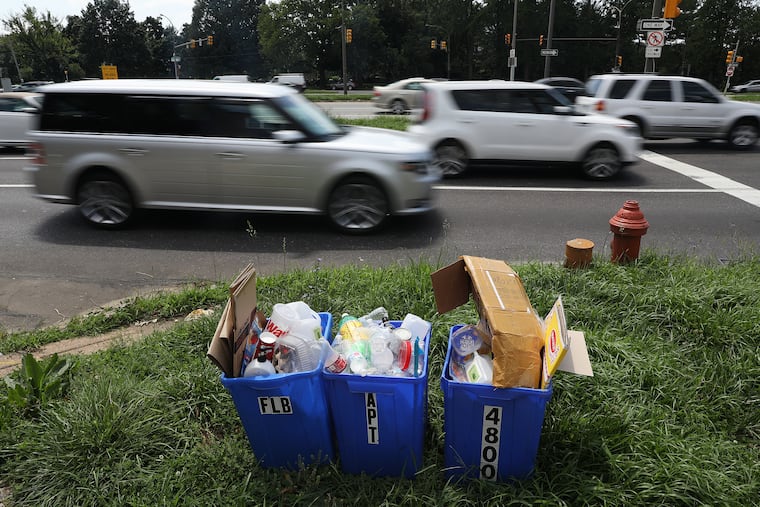Recycling in Philly has ‘improved significantly.’ Now officials are asking us to get back to sorting our trash.
In recent years, there hasn’t been a lot of good news about recycling. But Philly says it’s no longer mixing recycling with waste, and there’s renewed demand for plastic and cardboard.

Kyle Lewis, Philadelphia’s recycling program director, knows that residents were irked when Streets Department crews began mixing trash with recycling during the pandemic — the result of staff shortages and a big increase in residential waste as people spent more time at home. And they weren’t happy about the delays in pickup, either.
But the city is catching up.
Lewis said recycling pickups are largely back on track after extra hires were brought on and second shifts were added, though she concedes there still might be some rough patches. She encourages residents to call 311 to report any lingering issues.
“We’ve improved significantly,” Lewis said. “Right now, we’re on time with collections and about a half a day behind only in some areas in recycling. And so we definitely turned the corner, and are not mixing materials anymore.”
Lewis said that she knew the commingling of trash and recycling “was really frustrating for residents” and that she appreciates their patience. However, she fears that some gave up and are no longer recycling.
“We really want to encourage Philadelphians to continue to recycle,” Lewis said.
Recycling costs are down
One big positive: It’s costing the city less to recycle. During the height of the pandemic, Philadelphia was paying about $100 a ton to have its recycling processed. Now, it’s paying $68 to $70.
“Costs have gone down significantly,” Lewis said, largely because the market for recycled plastics is growing again.
Lewis and Waste Management, the city’s recycling processor, agree that loads need to get cleaner. Contamination of recycling, largely by residents tossing non-recyclable items in the stream, has been an issue since 2017 when China all but stopped taking plastics from the United States in an effort to cut down pollution.
Since then, municipalities and haulers have scrambled to find internal markets, which demand clean loads.
Demand for recyclables is rising
That comes as demand for recyclable materials is growing, largely because some states, including California, began passing laws that require certain percentages of post-consumer recycled resin in packaging.
At the same time, the demand for cardboard, or fiber, has grown, especially with the huge increase in online shopping as Amazon, Walmart, Target, and other retailers need boxes.
“Nationally, 2021 markets have been at record highs as demand for recycling material outpaces the current supply thanks to many companies making commitments to using more recycled content in their packages and products,” said John Hambrose, a spokesperson for Waste Management.
That comes as the Environmental Protection Agency announced its first national recycling strategy this week, saying the current “system is at a crossroads and desperately needs creative energy.” The agency acknowledged that many people are confused about which materials can be recycled, that recycling infrastructure is antiquated, and that markets are often turbulent. The strategy notes that plastics, derived from fossil fuels, help drive greenhouse gas emissions.
The EPA’s goal: a circular system in which a product or package is designed from the start to use not only less material but also material that can be readily recycled and made into new products.
Hambrose said consumer packaged goods are setting aggressive goals of up to 50% for recycled content.
To meet those goals, the capturing of recyclable plastics needs to grow about five times the current level, he said. Numbers 1, 2, and 5, labeled on the bottom of containers, are in particular demand.
And market values for corrugated cardboard are at 20-year highs. Waste Management has seen a 20% increase in cardboard collection over the last few years, largely due to online shopping, which increased during the pandemic.
To keep up with needs, Waste Management is completing $7 million in improvements at its materials recovery facility on Bleigh Avenue in Northeast Philadelphia. Work began in 2018 and should be finished by 2022.
Hambrose said the company wanted to improve efficiency at the building, and increase the quality of recovered recyclables it sells to its customers. Improvements include new screens for sorting to prevent foul-ups caused by plastic bags, plastic sheeting, and other items that get tangled in equipment.
Such items are part of the contamination that has plagued Philadelphia’s recycling, and those of many other communities.
Lewis said the city tries to educate people on what can and cannot be tossed in recycling bins. It’s important, she said, because entire contaminated loads have to be put in landfills — defeating the purpose of sorting trash for recycling.
According to Waste Management, recyclables should be loose (not bagged), and be clean and dry. Plastic bags need to be recycled through stores where the bags were generated.
Typical contaminating items include food waste; food-soiled bottles, cans, jars, and pizza boxes; as well as nonrecyclable plastics such as bowling balls, garden hoses, and pool covers. Even propane tanks get incorrectly tossed in with recycling.
What can be recycled?
Rinsed Numbers 1, 2, and 5 plastic bottles, jars, and tubs, including shampoo and laundry bottles, butter tubs, and yogurt containers.
Rinsed aluminum and tin cans and bottles.
Rinsed glass bottles or jars.
Clean and dry newsprint, magazines, junk mail, office paper, corrugated cardboard, and paperboard, such as gift and cereal boxes.
Pizza boxes with all food removed, and no more than a little bit of residual grease.